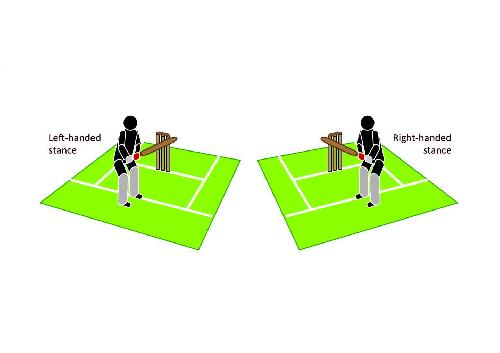Cricket batsmen who bat the 'wrong' way have a stunning advantage according to new research published in the scientific journal Sports Medicine. Batsmen who adopt a reversed stance (right-handed people who bat left-handed, and left-handers who bat right-handed) are far more likely to reach the first-class and international level, with professional batsmen being seven times more likely to adopt a reversed stance than the rest of the population. These are the results of research on professional and inexperienced cricket batsmen conducted by David Mann at Vrije Universiteit Amsterdam in the Netherlands, in collaboration with Oliver Runswick (St Mary's University, UK) and Peter Allen (Anglia Ruskin University, UK). The results suggest that a reversed stance leads to greater success and questions the way that similar sports (e.g. golf and baseball) are taught and performed.
A reversed stance may provide technical advantages
The reason for the advantage appears to be that the reversed stance places the dominant hand at the top rather than the bottom of the bat handle. VU-scientist David Mann: "The top hand is typically responsible for controlling and guiding the path of the bat to hit the ball, so it appears to be an advantage for the dominant hand to perform this role. The results suggest that by teaching batsmen to use a conventional stance, coaches may be inadvertently teaching players to bat 'back-to-front' and could be harming their players' chances of developing expertise. By adopting the conventional stance, batsmen may have been unintentionally taught to bat 'back-to-front' and might not have maximized their potential in the game."
 Left-handed and right-handed stance. Credit: David Mann
Left-handed and right-handed stance. Credit: David Mann
Why do we bat the way we do?
When playing cricket, baseball or golf, people are usually taught to adopt a 'right-handed' or 'left-handed' stance that places their dominant hand closer to the striking end of the bat. David Mann: "Surprisingly, it is not clear why this is the case, and until now it has been unknown whether doing so provides the best chance of developing skill."
Professional cricket players already use a reversed stance
The list of batsmen who have used a reversed stance over recent years at the international level is striking. In particular, some of the greatest batsmen of the modern era including Brian Lara, Clive Lloyd, David Gower, Adam Gilchrist, Alistair Cook, Michael Hussey, Kumar Sangakkara, and Matthew Hayden all bat left handed yet are actually right-hand dominant. The reversed-stance advantage also extends to people who are left-hand dominant but bat right-handed, with famous examples including Michael Clarke, Inzamam-ul-Haq, and Adam Voges. Even Sachin Tendulkar, probably the best batsmen of the modern era, batted and bowled right-handed, but is known to write with his left hand. It appears that in many cases the players adopted the reversed stance by chance. Mann: "Michael Hussey, one of Australia's finest cricketers, is right-hand dominant but learned to bat left handed to emulate his childhood idol, Allan Border."
The effect is present in the ICC T20 World Cup currently being played in India
The number of reversed-stance batsmen competing in the ICC T20 World Cup presently taking place in India is compelling, with the list including David Warner and Usman Khawaja (Australia); Chris Gayle (West Indies); Suresh Raina and Shikhar Dhawan (India); JP Duminy (South Africa); Thisara Perera (Sri Lanka); Eoin Morgan and Ben Stokes (England); Colin Munro (New Zealand), and Tamim Iqbal (Bangladesh). Surprisingly, half of the Australian batsmen/all-rounders bat using a reversed stance, as do 40% of the English and 33% of the South African, Sri Lankan, and Bangladesh batsmen/all-rounders.
source: Vrije Universiteit Amsterdam